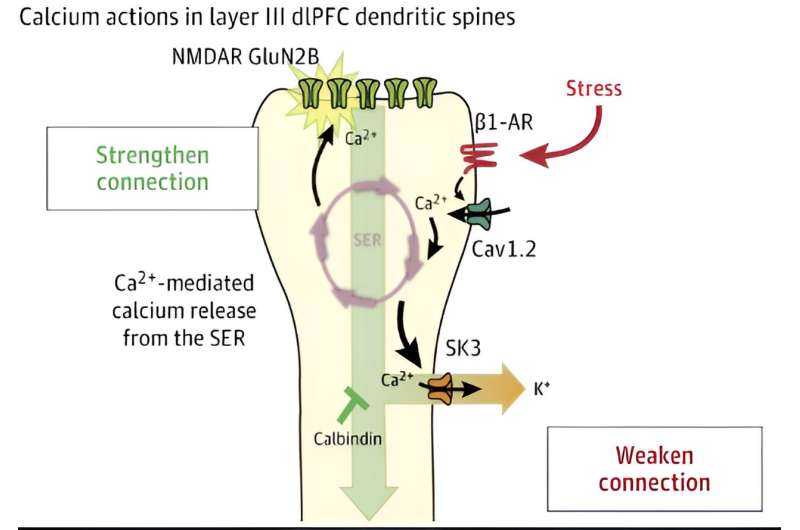
A new study from Yale School of Medicine has shown that the neurons that generate higher cognition, and are a target of pathology in Alzheimer’s disease and mental disorders such as schizophrenia, express an enrichment of calcium-related proteins that helps to explain their vulnerability to disease.
This finding builds on previous studies that determined that alterations in a gene known as CACNA1C are linked to increased risk of cognitive impairment and mental illness.
CACNA1C encodes calcium channels that enable the flow of calcium ions into neurons. For years, researchers have known that gain-of-function mutations in this gene, which can create more of these calcium channels, raise the risk for cognitive disorders, but they did not understand why this increase was harmful to the prefrontal cortex, which generates higher cognition and the executive functions.
Now, a Yale team has discovered that excessive calcium channel activation in the prefrontal cortex is associated with reduced neuronal firing, which in turn hinders cognition. The researchers published their findings in JAMA Psychiatry.
“Trying to learn what causes these complex cognitive disorders is an enormous challenge, especially when they’re attacking our most recently evolved brain circuits—you can’t just mimic this in a dish,” says Amy Arnsten, Ph.D., Albert E. Kent Professor of Neuroscience, who is the study’s senior author.
“Studies like this are some of the rare bridges between the molecular biology and the symptoms we see in humans, allowing us to understand what these circuits need to function properly, as well as their vulnerabilities.”
A link between calcium and abstract thought
To learn more about how CACNA1C mutations could increase risk of cognitive disorders, the researchers turned their attention to a group of cells known as layer III pyramidal cells. These are neurons in the prefrontal cortex that are highly important for the brain’s executive functions, such as abstract thinking and working memory. This group of cells is vulnerable to atrophy and neurodegeneration while, interestingly, their nearby neighbors typically remain unaffected.
Arnsten’s team employed a variety of methods, including running transcriptomic analyses (explorations of all RNA molecules in a cell) of human and animal pyramidal cells, to investigate these neurons’ susceptibility to dysfunction and their potential link to CACNA1C alteration. The researchers found that these neurons expressed signatures indicative of high calcium, including an assembly of calcium-related proteins.
The team then embarked on more in-depth studies of these molecules, including in animal models. Their findings suggest that increased calcium in pyramidal cells is necessary for higher cognition.
“We found evidence that these neurons require higher calcium to maintain their firing over many seconds to represent information that isn’t actually happening,” says Arnsten. “That’s the foundation of abstract thought.”
The researchers then infused a drug that mimics the stress response next to the prefrontal neurons. They found that stress activated the calcium channels, which in turn opened nearby potassium channels to stop the neurons from firing.
“Ever have your mind go blank when you get bad news or have to do public speaking?” said Arnsten. “That’s likely involving this mechanism.”
Clues for treating schizophrenia and Alzheimer’s disease
These findings have significant clinical implications for understanding the pathologies of cognitive disorders, including schizophrenia and Alzheimer’s disease, both of which are characterized by profound prefrontal cortex dysfunction.
Previous research has shown, for example, that gain-of-function mutations in CACNA1C raise risk for schizophrenia. The study offers evidence that the increase in calcium resulting from these mutations can lead to the atrophy associated with the condition.
Furthermore, the team’s transcriptomic analyses revealed that the pyramidal cells contain calbindin, a calcium-binding protein that plays an essential role in maintaining calcium homeostasis. However, over time, this important balance can be altered by aging or inflammation.
Prior research has shown that elevated calcium can propel tau pathology, a characteristic of Alzheimer’s disease, in which tau proteins become hyperphosphorylated and form tangles in the brain. Thus, as pyramidal cells in the prefrontal cortex age and lose calbindin, they become vulnerable to the neurodegenerative disorder.
Arnsten hopes these insights will lead to greater understanding of and, ultimately, better treatments for these conditions.
“We’ve uncovered big clues about which brain cells are most vulnerable and which are resilient,” she says. “If we can learn why certain cells are vulnerable, that also gives us clues about how to protect them.”
More information:
Dibyadeep Datta et al, Key Roles of CACNA1C/Cav1.2 and CALB1/Calbindin in Prefrontal Neurons Altered in Cognitive Disorders, JAMA Psychiatry (2024). DOI: 10.1001/jamapsychiatry.2024.1112
Citation:
How calcium channel mutations lead to cognitive dysfunction (2024, June 13)
retrieved 13 June 2024
from https://medicalxpress.com/news/2024-06-calcium-channel-mutations-cognitive-dysfunction.html
This document is subject to copyright. Apart from any fair dealing for the purpose of private study or research, no
part may be reproduced without the written permission. The content is provided for information purposes only.